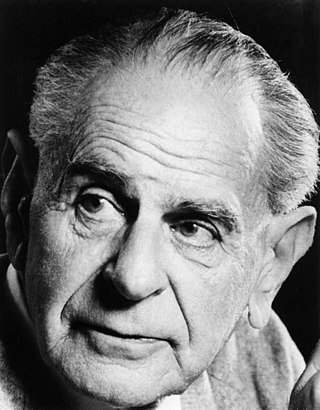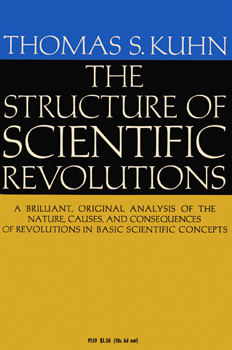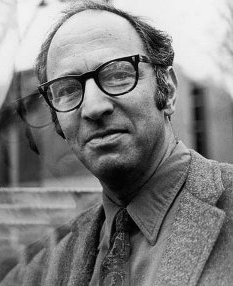Related Research Articles

Falsifiability is a deductive standard of evaluation of scientific theories and hypotheses, introduced by the philosopher of science Karl Popper in his book The Logic of Scientific Discovery (1934). A theory or hypothesis is falsifiable if it can be logically contradicted by an empirical test.

Sir Karl Raimund Popper was an Austrian–British philosopher, academic and social commentator. One of the 20th century's most influential philosophers of science, Popper is known for his rejection of the classical inductivist views on the scientific method in favour of empirical falsification. According to Popper, a theory in the empirical sciences can never be proven, but it can be falsified, meaning that it can be scrutinised with decisive experiments. Popper was opposed to the classical justificationist account of knowledge, which he replaced with critical rationalism, namely "the first non-justificational philosophy of criticism in the history of philosophy".
A paradigm shift is a fundamental change in the basic concepts and experimental practices of a scientific discipline. It is a concept in the philosophy of science that was introduced and brought into the common lexicon by the American physicist and philosopher Thomas Kuhn. Even though Kuhn restricted the use of the term to the natural sciences, the concept of a paradigm shift has also been used in numerous non-scientific contexts to describe a profound change in a fundamental model or perception of events.

Philosophy of science is the branch of philosophy concerned with the foundations, methods, and implications of science. Amongst its central questions are the difference between science and non-science, the reliability of scientific theories, and the ultimate purpose and meaning of science as a human endeavour. Philosophy of science focuses on metaphysical, epistemic and semantic aspects of scientific practice, and overlaps with metaphysics, ontology, logic, and epistemology, for example, when it explores the relationship between science and the concept of truth. Philosophy of science is both a theoretical and empirical discipline, relying on philosophical theorising as well as meta-studies of scientific practice. Ethical issues such as bioethics and scientific misconduct are often considered ethics or science studies rather than the philosophy of science.

Imre Lakatos was a Hungarian philosopher of mathematics and science, known for his thesis of the fallibility of mathematics and its "methodology of proofs and refutations" in its pre-axiomatic stages of development, and also for introducing the concept of the "research programme" in his methodology of scientific research programmes.
In science and philosophy, a paradigm is a distinct set of concepts or thought patterns, including theories, research methods, postulates, and standards for what constitute legitimate contributions to a field. The word paradigm is Greek in origin, meaning "pattern".

The Latin phrase odium theologicum is the name originally given to the often intense anger and hatred generated by disputes over theology. It has also been adopted to describe non-theological disputes of a rancorous nature.

The Structure of Scientific Revolutions is a book about the history of science by the philosopher Thomas S. Kuhn. Its publication was a landmark event in the history, philosophy, and sociology of science. Kuhn challenged the then prevailing view of progress in science in which scientific progress was viewed as "development-by-accumulation" of accepted facts and theories. Kuhn argued for an episodic model in which periods of conceptual continuity and cumulative progress, referred to as periods of "normal science", were interrupted by periods of revolutionary science. The discovery of "anomalies" during revolutions in science leads to new paradigms. New paradigms then ask new questions of old data, move beyond the mere "puzzle-solving" of the previous paradigm, alter the rules of the game and change the "map" directing new research.
Scientific consensus is the generally held judgment, position, and opinion of the majority or the supermajority of scientists in a particular field of study at any particular time.
In philosophy of science and epistemology, the demarcation problem is the question of how to distinguish between science and non-science. It also examines the boundaries between science, pseudoscience and other products of human activity, like art and literature and beliefs. The debate continues after more than two millennia of dialogue among philosophers of science and scientists in various fields. The debate has consequences for what can be termed "scientific" in topics such as education and public policy.
Commensurability is a concept in the philosophy of science whereby scientific theories are said to be "commensurable" if scientists can discuss the theories using a shared nomenclature that allows direct comparison of them to determine which one is more valid or useful. On the other hand, theories are incommensurable if they are embedded in starkly contrasting conceptual frameworks whose languages do not overlap sufficiently to permit scientists to directly compare the theories or to cite empirical evidence favoring one theory over the other. Discussed by Ludwik Fleck in the 1930s, and popularized by Thomas Kuhn in the 1960s, the problem of incommensurability results in scientists talking past each other, as it were, while comparison of theories is muddled by confusions about terms, contexts and consequences.

Postpositivism or postempiricism is a metatheoretical stance that critiques and amends positivism and has impacted theories and practices across philosophy, social sciences, and various models of scientific inquiry. While positivists emphasize independence between the researcher and the researched person, postpositivists argue that theories, hypotheses, background knowledge and values of the researcher can influence what is observed. Postpositivists pursue objectivity by recognizing the possible effects of biases. While positivists emphasize quantitative methods, postpositivists consider both quantitative and qualitative methods to be valid approaches.

The sociology of the history of science—related to sociology and philosophy of science, as well as the entire field of science studies—has in the 20th century been occupied with the question of large-scale patterns and trends in the development of science, and asking questions about how science "works" both in a philosophical and practical sense.
In computer science, the scientific community metaphor is a metaphor used to aid understanding scientific communities. The first publications on the scientific community metaphor in 1981 and 1982 involved the development of a programming language named Ether that invoked procedural plans to process goals and assertions concurrently by dynamically creating new rules during program execution. Ether also addressed issues of conflict and contradiction with multiple sources of knowledge and multiple viewpoints.
Inductivism is the traditional and still commonplace philosophy of scientific method to develop scientific theories. Inductivism aims to neutrally observe a domain, infer laws from examined cases—hence, inductive reasoning—and thus objectively discover the sole naturally true theory of the observed.
A research program is a professional network of scientists conducting basic research. The term was used by philosopher of science Imre Lakatos to blend and revise the normative model of science offered by Karl Popper's The Logic of Scientific Discovery and the descriptive model of science offered by Thomas Kuhn's The Structure of Scientific Revolutions. Lakatos found falsificationism impractical and often not practiced, and found normal science—where a paradigm of science, mimicking an exemplar, extinguishes differing perspectives—more monopolistic than actual.
Critical reading is a form of language analysis that does not take the given text at face value, but involves a deeper examination of the claims put forth as well as the supporting points and possible counterarguments. The ability to reinterpret and reconstruct for improved clarity and readability is also a component of critical reading. The identification of possible ambiguities and flaws in the author's reasoning, in addition to the ability to address them comprehensively, are essential to this process. Critical reading, much like academic writing, requires the linkage of evidential points to corresponding arguments.

Thomas Samuel Kuhn was an American historian and philosopher of science whose 1962 book The Structure of Scientific Revolutions was influential in both academic and popular circles, introducing the term paradigm shift, which has since become an English-language idiom.
Bold hypothesis or bold conjecture is a concept in the philosophy of science of Karl Popper, first explained in his debut The Logic of Scientific Discovery (1935) and subsequently elaborated in writings such as Conjectures and Refutations: The Growth of Scientific Knowledge (1963). The concept is nowadays widely used in the philosophy of science and in the philosophy of knowledge. It is also used in the social and behavioural sciences.
The Kuhn-Popper debate was a debate surrounding research methods and the advancement of scientific knowledge. In 1965, at the University of London's International Colloquium in the Philosophy of Science, Thomas Kuhn and Karl Popper engaged in a debate that circled around three main areas of disagreement. These areas included the concept of a scientific method, the specific behaviors and practices of scientists, and the differentiation between scientific knowledge and other forms of knowledge.
References
- ↑ J. Childers/G. Hentzi eds., The Columbia Dictionary of Modern Literary and Cultural Criticism (1995) p. 110
- ↑ Childers, p. 84
- ↑ T. S. Kuhn, The Structure of Scientific Revolutions (1962) p. 35-42
- ↑ Kuhn, p. 10-22
- ↑ A. Rosenberg, Philosophy of Science (2005) p. 149
- ↑ Kuhn, p. 25-8
- ↑ Kuhn, p. 23
- ↑ Kuhn, p. 42
- ↑ Kuhn, p. 24
- ↑ Kuhn, p. 34
- ↑ Kuhn, p. 97
- ↑ Kuhn, p. 145
- ↑ Kuhn, p. 52-78
- ↑ Kuhn, p. 53
- ↑ Kuhn, p. 90
- ↑ Kuhn, p. 92
- ↑ Kuhn, p. 181
- ↑ I. Lakatos, Falsification and the Methodology of Scientific Research Programmes (1970) p. 93
- ↑ Lakatos, p. 132
- ↑ Lakatos, p. 133
- ↑ Lakatos, p. 163
- ↑ Lakatos, p. 178
- 1 2 Kuhn, 170-171